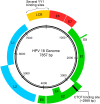Long-distance communication: Looping of human papillomavirus genomes regulates expression of viral oncogenes
- PMID: 30481166
- PMCID: PMC6286019
- DOI: 10.1371/journal.pbio.3000062
Long-distance communication: Looping of human papillomavirus genomes regulates expression of viral oncogenes
Abstract
High-risk human papillomaviruses (HPVs) are a major cause of cancers. HPVs infect epithelial cells, and viral oncogenes disrupt several cellular processes, including cell division, differentiation, and apoptosis. Expression of these oncogenes is relatively low in undifferentiated epithelial cells but increases in differentiating cells by unknown mechanisms. In a new study, Parish and colleagues unveil how two cellular proteins, CCCTC-binding factor (CTCF) and Yin Yang 1 (YY1), mediate looping of the HPV18 genome, which regulates expression of viral oncogenes in both dividing and differentiating epithelial cells.
Conflict of interest statement
The authors have declared that no competing interests exist.
Figures

Comment on
-
CCCTC-binding factor recruitment to the early region of the human papillomavirus 18 genome regulates viral oncogene expression.J Virol. 2015 May;89(9):4770-85. doi: 10.1128/JVI.00097-15. Epub 2015 Feb 18. J Virol. 2015. PMID: 25694598 Free PMC article.
Similar articles
-
Disruption of CTCF-YY1-dependent looping of the human papillomavirus genome activates differentiation-induced viral oncogene transcription.PLoS Biol. 2018 Oct 25;16(10):e2005752. doi: 10.1371/journal.pbio.2005752. eCollection 2018 Oct. PLoS Biol. 2018. PMID: 30359362 Free PMC article.
-
Yin yang 1 negatively regulates the differentiation-specific E1 promoter of human papillomavirus type 6.J Virol. 2000 Jun;74(11):5198-205. doi: 10.1128/jvi.74.11.5198-5205.2000. J Virol. 2000. PMID: 10799595 Free PMC article.
-
Quantitative role of the human papillomavirus type 16 E5 gene during the productive stage of the viral life cycle.J Virol. 2003 Mar;77(5):2832-42. doi: 10.1128/jvi.77.5.2832-2842.2003. J Virol. 2003. PMID: 12584306 Free PMC article.
-
Cellular control of human papillomavirus oncogene transcription.Mol Carcinog. 1994 Jul;10(3):134-41. doi: 10.1002/mc.2940100304. Mol Carcinog. 1994. PMID: 8043195 Review.
-
Papillomavirus E6 and E7 proteins and their cellular targets.Front Biosci. 2008 Jan 1;13:1003-17. doi: 10.2741/2739. Front Biosci. 2008. PMID: 17981607 Review.
References
-
- Plummer M, de Martel C, Vignat J, Ferlay J, Bray F, Franceschi S. Global burden of cancers attributable to infections in 2012: a synthetic analysis. Lancet Glob Heal. 2016; 4(9): e609–16. - PubMed
-
- Tommasino M. The human papillomavirus family and its role in carcinogenesis. Seminars in Cancer Biology. 2014; 26:13–21. 10.1016/j.semcancer.2013.11.002 - DOI - PubMed
-
- Moody CA. Mechanisms by which HPV induces a replication competent environment in differentiating keratinocytes. Viruses. 2017; 10.3390/v9090261 - DOI - PMC - PubMed
-
- Butz K, Ristriani T, Hengstermann A, Denk C, Scheffner M, Hoppe-Seyler F. siRNA targeting of the viral E6 oncogene efficiently kills human papillomavirus-positive cancer cells. Oncogene. 2003; 22(38): 5938–45. 10.1038/sj.onc.1206894 - DOI - PubMed
-
- Jiang M, Milner J. Selective silencing of viral gene expression in HPV-positive human cervical carcinoma cells treated with siRNA, a primer of RNA interference. Oncogene. 2002; 21(39): 6041–8. 10.1038/sj.onc.1205878 - DOI - PubMed
Publication types
MeSH terms
Substances
Grants and funding
LinkOut - more resources
Full Text Sources

